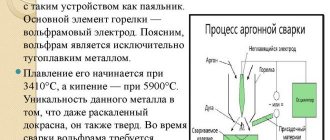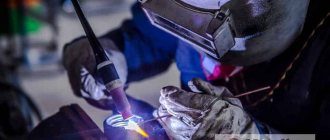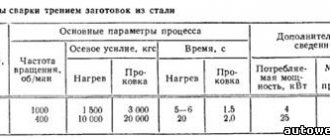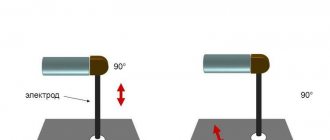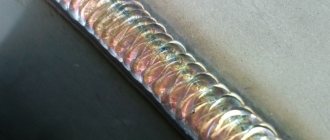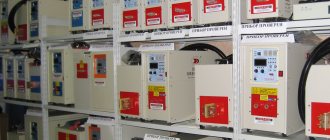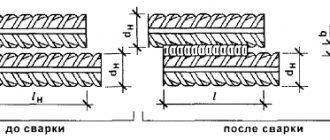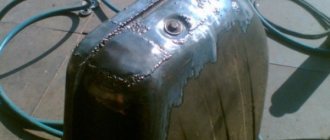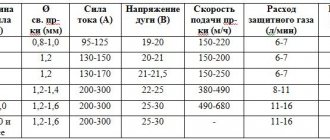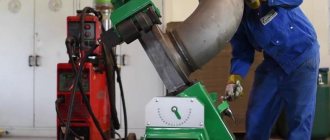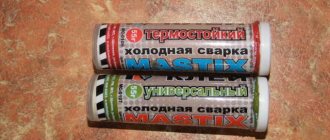08/28/2020 Author: VT-METALL
Issues discussed in the material:
- 3 reasons to weld fuel tanks
- General rules for welding fuel tanks
- Step-by-step algorithm for tank repair and welding
- Features of cold welding for fuel tanks
- Alternative tank welding options
Welding of tanks is necessary if the seal is broken and a leak occurs. Such a malfunction may occur due to physical wear or due to damage with crushing of the housing. Fuel vapors can accumulate in an empty gas tank, so use conventional welding and heating with extreme caution, as this can cause an explosion.
Many car owners think about how to properly weld the tank and troubleshoot the problem. There are different repair methods: argon arc and cold welding, soldering. Each of them has its own characteristics. Let's look at the technologies in detail and figure out what is best to choose.
General rules for welding fuel tanks
A leak in the fuel tank can be indicated when fuel consumption increases and a specific smell appears in the vehicle interior. Even if the size of the crack is very small, it poses a serious threat to the life of the driver and passengers. If a spark hits the leak, the fuel will ignite. The causes of cracks are corrosion, cracking of the tank body when driving.
Another reason is the discharged pressure, which gradually increases the size of the cracks through which fuel begins to flow. Before you start welding tanks, you must:
- empty the fuel tank of fuel;
- remove the tank, dry it, inspect for damage;
- wash the inside of the tank using special detergents;
- rinse thoroughly with water and dry.
Thanks to washing, the container is completely cleared of explosive vapors. The choice of repair method depends on the material from which the container is made. Metal fuel tanks are restored using argon welding, plastic ones - through cold welding, hot soldering is considered a universal method. Let's take a closer look at self-repair of the fuel tank.
Application options
Storage tanks are relevant in places where there are interruptions in water supply. Indoors, water tanks are most often installed in a horizontal position.
The tanks are used to store rainwater and tap water. With their help, you can organize an outdoor shower or keep them for fire safety purposes so that you can extinguish the fire.
They can store water for watering plants, gardens and vegetable gardens. Often round tanks are installed in a bathhouse to store water. There are many designs that can be round, rectangular or other shapes.
It is important to understand what the tank is for. If it is used inactively, the water in it promotes the growth of algae and microorganisms. Moreover, if the container is constantly located in an open area under the sun's rays.
Therefore, choosing the volume of the tank is one of the main tasks before starting its manufacture. Ferrous metal tanks must be primed and painted to prevent them from rusting.
Tank repair and welding: step-by-step algorithm
Let's talk about welding tanks, the operating procedure, possible complications and ways to solve problems that arise.
1. How to remove?
The method of dismantling the fuel tank differs for different brands of cars. You can remove any tank using a medium set of tools.
The step-by-step algorithm of actions will be as follows:
- The fuel from the tank is drained into a previously prepared container through a drain plug located at the bottom of the tank. If there is no plug, the fuel will have to be pumped out manually using a special hose.
- The sensors and ventilation hose are disconnected from the fuel tank. Modern car models use quick-release connections located under the rear row of seats or in the trunk.
- The fuel supply fastening clamps are loosened and the tubes are removed.
- The tank mounts are removed. Most of the car components are secured using two clamps, which are secured with nuts. To remove the container, it is worth hiring an assistant who will hold it during the process.
- The filler plug is unscrewed and the seal is removed.
- The ground terminal is removed.
- The fuel tank is dismantled.
The tank is assessed for damage. In some cases, welding of stainless steel tanks can be done without dismantling them, just enough to be able to reach the damaged area with the electrode.
2. Cleaning.
Before you start welding tanks with a semi-automatic machine, they must be cleaned both outside and inside, completely removing dirt and traces of fuel. Then a suitable welding method is selected.
We recommend articles on metalworking
- Steel grades: classification and interpretation
- Aluminum grades and areas of their application
- Defects in metal products: causes and search methods
3. How to solder?
Safety precautions require pouring water into the tank before welding to prevent detonation of fuel vapors. At the preparation stage, the container is cleaned of paint and rust.
The algorithm for welding tanks with minor damage is described below:
- The location of the leak is detected.
- The damaged area is cleaned and, if necessary, the geometry of the node is restored.
- The leak area is degreased using any solvent.
- The crack is treated with soldering acid.
- The surface is heated with a hairdryer or incandescent lamp.
- Surfacing is being carried out. If the damaged area is large enough, surfacing is performed in several layers.
- Remains of rosin are removed with a solvent.
You can also weld tanks with argon.
Features of cold welding of fuel tanks
Cold welding of tanks is used for plastic or metal containers. The effectiveness of this method will be low when working with thin-walled tanks. The choice of adhesive depends on the type of material. Work with cold welding is carried out with gloves. The damaged part of the container is cleaned and degreased using nefras.
The combination of two-component mixtures is carried out in the proportions specified by the manufacturer, the finished solution is used no later than 10–20 minutes after preparation. The composition is applied layer by layer to the damaged area and smoothed. The tank can be used 2-3 hours after cold welding plastic tanks. Before using glue in the form of a bar, it must be thoroughly kneaded with wet hands, then the crack must be covered.
When choosing cold welding, it is important to remember its resistance to gasoline. This repair option only applies to minor damage. Minor leaks can be repaired with Moment glue or a similar composition. To do this, cut a rag, soak it with glue and glue it to the crack in several layers. We should not forget that this is only a temporary measure to allow you to get to the service station.
Alternative tank welding options
- Soldering.
Soldering the tanks makes them more resistant to mechanical stress and external factors. To fix the crack, you should prepare a patch made of the same material as the fuel tank itself. The size of the patch should be 4-5 cm larger than the area of damage. The type of plastic is indicated on the parts. Most tanks are made of ABS, polypropylene or polyamide. Plastic containers are soldered from the outside with a 250-watt soldering iron.To improve the quality of the repair, you should use a substrate made of copper or metal fine reinforcing mesh. It is fused into the wall of the fuel container, then liquid plastic is evenly distributed throughout the crack area until the new coating becomes uniform. In the repair process, speed of work is important; too slow actions are fraught with hardening of the plastic and the formation of sagging.
Welding of metal tanks can be done using a thin metal or copper patch. To do this, the container is heated with a blowtorch or iron. The patch is attached with low-melting solder to the damaged area with a 500-watt soldering iron, and the joint is treated with soldering acid. After the sealed container has cooled, the repaired area is treated with paint or bitumen mastic to protect it from corrosion.
- Repair using electric welding.
The most reliable method of repair is argon arc welding of tanks. The use of tungsten electrodes allows you to reliably connect non-ferrous metal and alloy steel. For the production of most fuel tanks, aluminum is used, and therefore the use of inverter welding is impossible. The defect area is cleaned of fats and contaminants. The patch is welded around the entire perimeter of the hole. To obtain an even and durable seam, it is necessary to maintain a homogeneous gas environment during the welding process. After the tank body has cooled, it is painted or treated with bitumen mastic. - Repair of a plastic gas tank.
The fastest way to repair a damaged fuel tank is with epoxy glue. However, do not forget that such repairs are temporary, allowing you to get to the service station. The holes are patched with a plastic welder - an extruder. To perform such welding of tanks, experience and knowledge of technology are required. Before you start working, it's worth practicing. To correctly calculate the productivity of the extruder, you should know the transverse size of the crack.Welding of tanks begins from the edge of the defect. The melted plastic wire is laid with a small margin along the entire width of the hole. To improve the repair efficiency, it is necessary to move the extruder so that the wire crosses the crack, filling it. For an even seam, it is important to uniformly heat the hot air gun and the machine shoe.
Upon completion of the repair, the tightness of the container is checked. Leaks can be detected by pressure testing with an operating air pressure of 10–15 kPa.
If there is no compressor and a container of water, you can use the traditional method of checking:
- place the dry tank on a clean cloth;
- pour kerosene into it;
- wait 12 hours.
If no stains appear on the fabric, the container is sealed and ready for use.
Welding tanks requires certain skills. It is important not to forget to check its tightness after restoration. If you strictly follow the repair technology, the tank will return to its original characteristics.
Tig welding technology
During operation, refractory tungsten electrodes are used. The electrode is surrounded by a ceramic nozzle from which gas emerges under high pressure. Thanks to this, welding of a gas tank with argon takes place in an airless environment.
This technique allows you to accurately regulate the depth of metal melting. The resulting seam can withstand temperature fluctuations over a wide range. The high quality of the seam allows it to withstand shocks and loads without depressurization. During the process the following devices are used:
- Power contactor - supplies welding voltage to the torch.
- Transformer - provides no-load voltage from 60 to 70 V.
- Oscillator - stabilizes the arc.
- Tungsten electrodes - selected for the specifics of the welding process (differ in diameter).
- Auxiliary transformer - needed for the operation of the switching device.
- Ammeter - helps measure welding current.
A gas cylinder and burner are also required during operation. According to welding standards, specialists use glasses and special clothing. The presence of all these elements allows us to guarantee high quality and durability of the seam.
